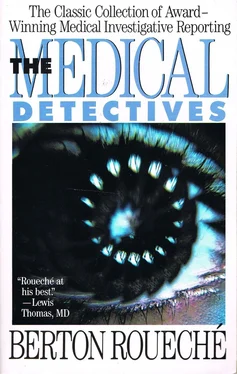Except for a brief period around the beginning of this century, when several European countries refused, because of its dubious nature, to import American pork, the adoption of a less porous system of control has never been seriously contemplated here. One reason is that it would run into money. Another is that, except by a few informed authorities, it has always been considered unnecessary. Trichinosis is generally believed to be a rarity. This view, though hallucinated, is not altogether without explanation. Outbreaks of trichinosis are seldom widely publicized. They are seldom even recognized. Trichinosis is the chameleon of diseases. Nearly all diseases are anonymous at onset, and many tend to resist identification until their grip is well established, but most can eventually be identified by patient scrutiny. Trichinosis is occasionally impervious to bedside detection at any stage. Even blood counts sometimes inexplicably fail to reveal its presence at any stage in its development. As a diagnostic deadfall, it is practically unique. The number and variety of ailments with which it is more or less commonly confused approach the encyclopedic. They include arthritis, acute alcoholism, conjunctivitis, food poisoning, lead poisoning, heart disease, laryngitis, mumps, asthma, rheumatism, rheumatic fever, rheumatic myocarditis, gout, tuberculosis, angioneurotic edema, dermatomyositis, frontal sinusitis, influenza, nephritis, peptic ulcer, appendicitis, cholecystitis, malaria, scarlet fever, typhoid fever, paratyphoid fever, undulant fever, encephalitis, gastroenteritis, intercostal neuritis, tetanus, pleurisy, colitis, meningitis, syphilis, typhus, and cholera. It has even been mistaken for beriberi. With all the rich inducements to error, a sound diagnosis of trichinosis is rarely made, and the diagnostician cannot always take much credit for it. Often, as at Metropolitan Hospital that April day in 1942, it is forced upon him.
The report of the arresting discovery at Metropolitan reached the Health Department on the morning of Friday, April 17. Its form was conventional—a postcard bearing a scribbled name, address, and diagnosis—and it was handled with conventional dispatch. Within an hour, Dr. Morris Greenberg, who was then chief epidemiologist of the Bureau of Preventable Diseases and is now its director, had put one of his fleetest agents on the case, a field epidemiologist named Lawrence Levy. Ten minutes after receiving the assignment, Dr. Levy was on his way to the hospital, intent on tracking down the source of the infection, with the idea of alerting the physicians of other persons who might have contracted the disease along with Sauer. At eleven o'clock, Dr. Levy walked into the office of the medical superintendent at Metropolitan. His immediate objective was to satisfy himself that Sauer was indeed suffering from trichinosis. He was quickly convinced. The evidence of the eosinophile count was now supported in the record by more graphic proof. Sauer, the night before, had undergone a biopsy. A sliver of muscle had been taken from one of his legs and examined under a microscope. It teemed with Trichinella spiralis.
On the basis of the sample, the record noted, the pathologist who made the test estimated the total infestation of trichinae at upward of twelve million. A count of over five million is almost invariably lethal. Dr. Levy returned the dossier to the file. Then, moving on to his more general objective, he had a word with the patient. He found him bemused but conscious. Sauer appeared at times to distantly comprehend what was said to him, but his replies were faint and rambling and mostly incoherent. At the end of five minutes, Dr. Levy gave up. He hadn't learned much, but he had learned something, and he didn't have the heart to go on with his questioning. It was just possible, he let himself hope, that he had the lead he needed. Sauer had mentioned the New York Labor Temple, a German-American meeting-and-banquet hall on East Eighty-fourth Street, and he had twice uttered the word " Schlachtfest ". A Schlachtfest , in Yorkville, the Doctor knew, is a pork feast.
Before leaving the hospital, Dr. Levy telephoned Dr. Greenberg and dutifully related what he had found out. It didn't take him long. Then he had a sandwich and a cup of coffee and headed for the Labor Temple, getting there at a little past one. It was, and is, a shabby yellow-brick building of six stories, a few doors west of Second Avenue, with a high, ornately balustraded stoop and a double basement. Engraved on the facade, just above the entrance, is a maxim: "Knowledge Is Power." In 1942, the Temple was owned and operated, on a non-profit basis, by the Workmen's Educational Association; it has since been acquired by private interests and is now given over to business and light manufacturing. A porter directed Dr. Levy to the manager's office, a cubicle at the end of a dim corridor flanked by meeting rooms. The manager was in, and, after a spasm of bewilderment, keenly cooperative. He brought out his records and gave Dr. Levy all the information he had. Sauer was known at the Temple. He had been employed there off and on for a year or more as a dishwasher and general kitchen helper, the manager related. He was one of a large group of lightly skilled wanderers from which the cook was accustomed to recruit a staff whenever the need arose. Sauer had last worked at the Temple on the nights of March 27 and March 28.
On the latter, as it happened, the occasion was a Schlachtfest.
Dr. Levy, aware that the incubation period of trichinosis is usually from seven to fourteen days and that Sauer had presented himself at Lenox Hill on April 6, motioned to the manager to continue. The Schlachtfest had been given by the Hindenburg Pleasure Society, an informal organization whose members and their wives gathered periodically at the Temple for an evening of singing and dancing and overeating. The arrangements for the party had been made by the secretary of the society—Felix Lindenhauser, a name which, like those of Sauer and the others I shall mention in connection with the Schlachtfest , is a fictitious one. Lindenhauser lived in St. George, on Staten Island. The manager's records did not indicate where the pork had been obtained. Probably, he said, it had been supplied by the society. That was frequently the case. The cook would know, but it was not yet time for him to come on duty. The implication of this statement was not lost on Dr. Levy. Then the cook, he asked, was well? The manager said that he appeared to be. Having absorbed this awkward piece of information, Dr. Levy inquired about the health of the others who had been employed in the kitchen on the night of March 28. The manager didn't know. His records showed, however, that, like Sauer, none of them had worked at the Temple since that night. He pointed out that it was quite possible, of course, that they hadn't been asked to. Dr. Levy noted down their names—Rudolf Nath, Henry Kuhn, Frederick Kreisler, and William Ritter—and their addresses. Nath lived in Queens, Kreisler in Brooklyn, and Kuhn and Ritter in the Bronx. Then Dr. Levy settled back to await the arrival of the cook. The cook turned up at three, and he, too, was very cooperative. He was feeling fine, he said. He remembered that Schlachtfest.
The pig, he recalled, had been provided by the society. Some of it had been ground up into sausage and baked. The rest had been roasted. All of it had been thoroughly cooked. He was certain of that. The sausage, for example, had been boiled for two hours before it was baked. He had eaten his share of both. He supposed that the rest of the help had, too, but there was no knowing. He had neither seen nor talked to any of them since the night of the feast. There had been no occasion to, he said.
Dr. Levy returned to his office, and sat there for a while in meditation. Presently, he put in a call to Felix Lindenhauser, the secretary of the society, at his home on Staten Island. Lindenhauser answered the telephone. Dr. Levy introduced himself and stated his problem. Lindenhauser was plainly flabbergasted. He said he was in excellent health, and had been for months. His wife, who had accompanied him to the Schlachtfest , was also in good health. He had heard of no illness in the society. He couldn't believe that there had been anything wrong with that pork. It had been delicious. The pig had been obtained by two members of the society, George Muller and Hans Breit, both of whom lived in the Bronx. They had bought it from a farmer of their acquaintance in New Jersey. Lindenhauser went on to say that there had been twenty-seven people at the feast, including himself and his wife. The names and addresses of the company were in his minute book. He fetched it to the phone and patiently read them off as Dr. Levy wrote them down. If he could be of any further help, he added as he prepared to hang up, just let him know, but he was convinced that Dr. Levy was wasting his time. At the moment, Dr. Levy was almost inclined to agree with him.
Читать дальше












